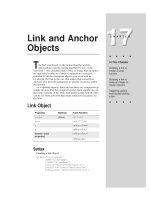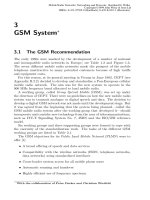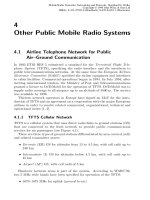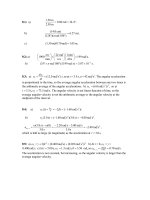Tài liệu Điện tử_ Chapter 01 pptx
Bạn đang xem bản rút gọn của tài liệu. Xem và tải ngay bản đầy đủ của tài liệu tại đây (571.09 KB, 46 trang )
ELECTRICAL ENGINEERING: PRINCIPLES AND APPLICATIONS, Third Edition, by Allan R. Hambley, ©2005 Pearson Education, Inc.
Chapter 1 Introduction
ELECTRICAL ENGINEERING: PRINCIPLES AND APPLICATIONS, Third Edition, by Allan R. Hambley, ©2005 Pearson Education, Inc.
Chapter 1
Introduction
1. Recognize interrelationships of
electrical engineering with other fields
of science and engineering.
2. List the major subfields of electrical
engineering.
3. List several important reasons for
studying electrical engineering.
ELECTRICAL ENGINEERING: PRINCIPLES AND APPLICATIONS, Third Edition, by Allan R. Hambley, ©2005 Pearson Education, Inc.
4. Define current, voltage, and power,
including their units.
5. Calculate power and energy, as well
as determine whether energy is supplied
or absorbed by a circuit element.
6. State and apply basic circuit laws.
7. Solve for currents, voltages, and
powers in simple circuits.
ELECTRICAL ENGINEERING: PRINCIPLES AND APPLICATIONS, Third Edition, by Allan R. Hambley, ©2005 Pearson Education, Inc.
Electrical systems have two
main objectives:
•
To gather, store, process, transport, and present
information
•
To distribute and convert energy between various
forms
ELECTRICAL ENGINEERING: PRINCIPLES AND APPLICATIONS, Third Edition, by Allan R. Hambley, ©2005 Pearson Education, Inc.
Electrical Engineering
Subdivisions
•
Communication
systems
•
Computer systems
•
Control systems
•
Electromagnetics
•
Electronics
•
Photonics
•
Power systems
•
Signal processing
ELECTRICAL ENGINEERING: PRINCIPLES AND APPLICATIONS, Third Edition, by Allan R. Hambley, ©2005 Pearson Education, Inc.
Why Study Electrical Engineering?
•
To pass the Fundamentals of Engineering (FE)
Examination
•
So you can lead projects in your own field
•
To be able to operate and maintain electrical
systems
•
To communicate with electrical engineering
consultants
ELECTRICAL ENGINEERING: PRINCIPLES AND APPLICATIONS, Third Edition, by Allan R. Hambley, ©2005 Pearson Education, Inc.
ELECTRICAL ENGINEERING: PRINCIPLES AND APPLICATIONS, Third Edition, by Allan R. Hambley, ©2005 Pearson Education, Inc.
Electrical Current
Electrical current is the time rate of flow of
electrical charge through a conductor or
circuit element. The units are amperes (A),
which are equivalent to coulombs per
second (C/s).
ELECTRICAL ENGINEERING: PRINCIPLES AND APPLICATIONS, Third Edition, by Allan R. Hambley, ©2005 Pearson Education, Inc.
Electrical Current
∫
+=
=
t
t
tqdttitq
dt
tdq
ti
0
)()()(
)(
)(
0
ELECTRICAL ENGINEERING: PRINCIPLES AND APPLICATIONS, Third Edition, by Allan R. Hambley, ©2005 Pearson Education, Inc.
ELECTRICAL ENGINEERING: PRINCIPLES AND APPLICATIONS, Third Edition, by Allan R. Hambley, ©2005 Pearson Education, Inc.
ELECTRICAL ENGINEERING: PRINCIPLES AND APPLICATIONS, Third Edition, by Allan R. Hambley, ©2005 Pearson Education, Inc.
Direct Current
Alternating Current
When a current is constant with time, we
say that we have direct current,
abbreviated as dc. On the other hand, a
current that varies with time, reversing
direction periodically, is called alternating
current, abbreviated as ac.
ELECTRICAL ENGINEERING: PRINCIPLES AND APPLICATIONS, Third Edition, by Allan R. Hambley, ©2005 Pearson Education, Inc.
.
ELECTRICAL ENGINEERING: PRINCIPLES AND APPLICATIONS, Third Edition, by Allan R. Hambley, ©2005 Pearson Education, Inc.
ELECTRICAL ENGINEERING: PRINCIPLES AND APPLICATIONS, Third Edition, by Allan R. Hambley, ©2005 Pearson Education, Inc.
ELECTRICAL ENGINEERING: PRINCIPLES AND APPLICATIONS, Third Edition, by Allan R. Hambley, ©2005 Pearson Education, Inc.
Voltages
The voltage associated with a circuit
element is the energy transferred per unit of
charge that flows through the element. The
units of voltage are volts (V), which are
equivalent to joules per coulomb (J/C).
ELECTRICAL ENGINEERING: PRINCIPLES AND APPLICATIONS, Third Edition, by Allan R. Hambley, ©2005 Pearson Education, Inc.
ELECTRICAL ENGINEERING: PRINCIPLES AND APPLICATIONS, Third Edition, by Allan R. Hambley, ©2005 Pearson Education, Inc.









